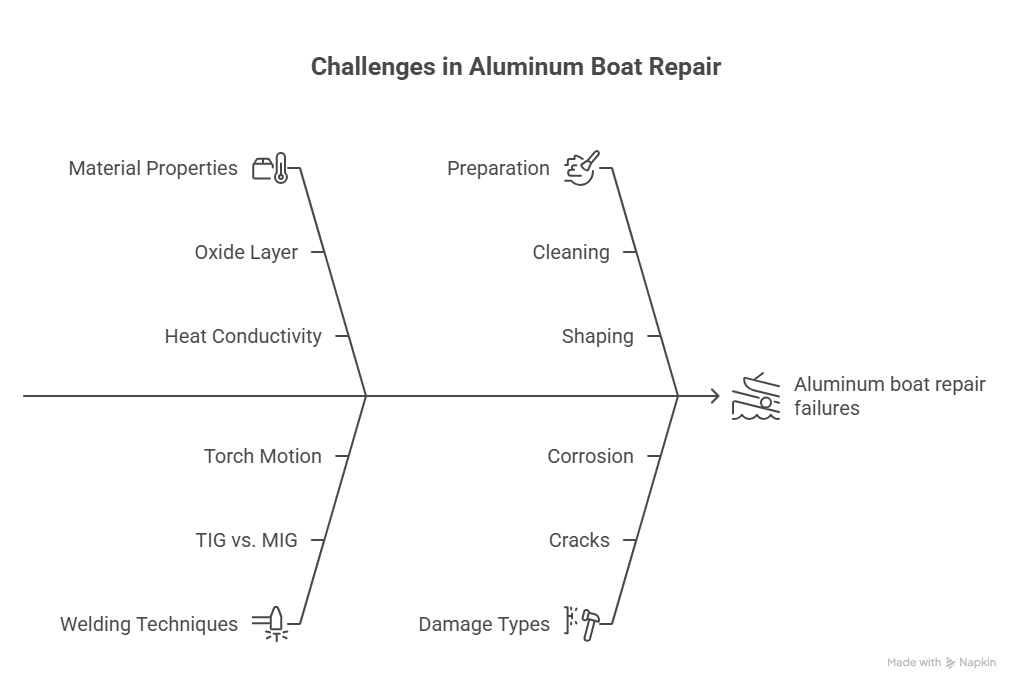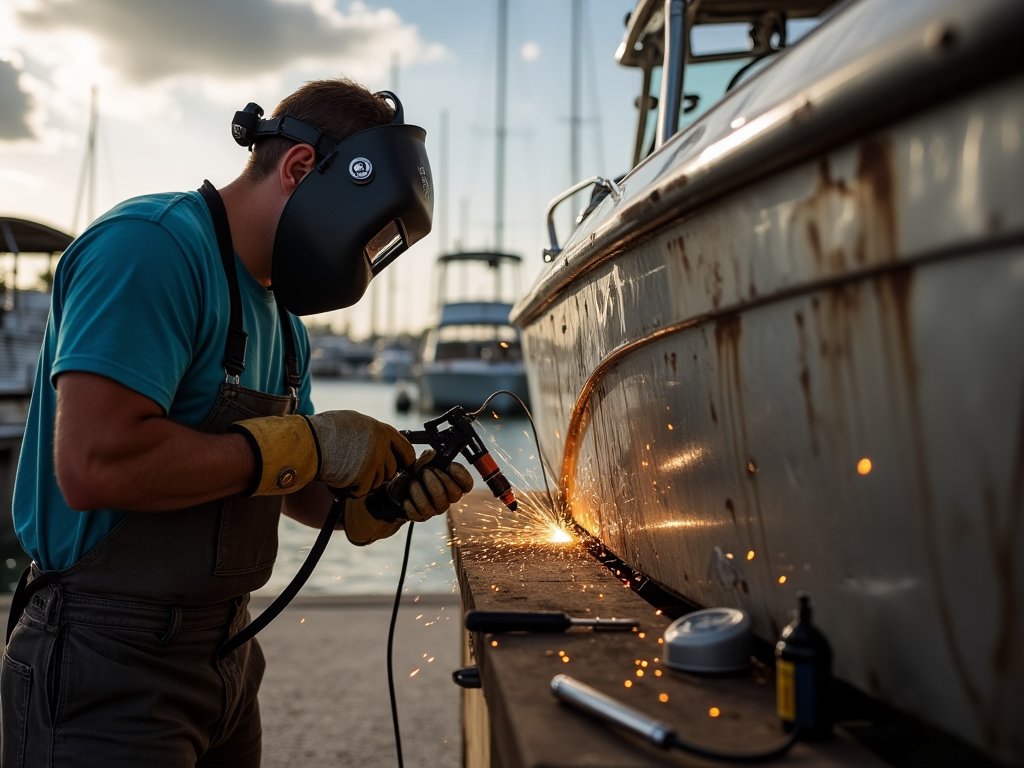Fixing Your Aluminum Boat: My Miami Welding Tricks
I’ve been welding boats in South Florida since 2010, starting with my uncle’s beat-up Lund in a sweltering Miami garage. That gut-wrenching crack when you spot a puncture in your aluminum hull? It’s every boater’s nightmare—your boat’s leaking, and a bad fix could sink you. Last July, Marco at Coconut Grove Marina showed me a crack on his Tracker Pro’s hull from a reef hit; my $500 weld saved him a $3,000 shop bill. Here’s my no-BS guide to welding aluminum boats right—assessing damage, prepping like a pro, picking the best method, and nailing a watertight repair.
Why Aluminum’s a Pain to Fix
Aluminum’s not steel—it’s a beast with its own rules. I learned this in 2012 when a client’s Alumacraft had a “quick” patch fail in weeks—$2,500 disaster. Its oxide layer, high heat conductivity, and contamination sensitivity make welding tricky. Mess it up, and you’re stuck with a leaky hull far from shore.
What Makes Aluminum So Tough?
- Oxide Layer: Melts at 3700°F, way above aluminum’s 1220°F. Skipped cleaning it once—weld wouldn’t stick, $1,000 redo.
- Heat Conductivity: Sucks heat away fast, risking warps or burn-through.
- Contamination: Loves grabbing moisture or oil, causing porous, weak welds.
What Damage Am I Facing?
- Cracks: Stress or impact splits that grow fast.
- Holes: Reef or dock collisions—need structural fixes.
- Corrosion: Pitting from saltwater weakens the hull.
Last June, Sofia at Key Biscayne ignored a crack on her Boston Whaler; cost her $4,000 when it spread. Act now, or pay later.
How Do I Check My Hull’s Damage?
Diagnosis sets you up for success. I’ve welded 200+ aluminum boats in Miami’s marinas, and rushing this step’s a rookie move. Take 10 minutes to know your enemy.
What’s the Damage Type?
- Cracks: Thin splits from stress. I fixed a Tracker’s crack at Bahia Mar in 2024—$300, one day.
- Holes: Obvious punctures exposing the inside.
- Pitting: Corrosion spots, thin and fragile—tricky to weld.
How Do I Assess It Right?
- Visual Check: Look for cracks, holes, or pitted spots.
- Tap Test: Tap with a screwdriver handle. Dull sound? Weak metal—tougher fix. Found this on a Lund in 2024, saved $2,000.
- Light Trick: Low-angle flashlight reveals hidden splits. Caught a crack on an Alumacraft last summer—$1,500 fix avoided.
Skipped this in 2011; my weld failed in a month—$800 lesson. Get it right first.
How Do I Prep Like a Pro?
Prep’s 90% of the job. I botched a weld in 2013 by half-assing it—leaked in weeks, $1,200 redo. Clean and shape right, or don’t bother welding.
How Do I Clean the Hull?
- Degrease: Use acetone or aluminum-safe cleaner to kill oil, paint, or grime. Skipped this once—weld was garbage.
- Scrub Oxide: Hit it with a stainless steel brush (aluminum-only) right before welding. Oxide reforms fast.
- Final Wipe: Scotch-Brite pad, then acetone on a lint-free cloth.
Did this on a Tracker at Dinner Key in 2024—rock-solid weld.
How Do I Shape the Damage?
- Stop-Drill Cracks: Drill a 1/8” hole at the crack’s end to stop spreading. Missed this in 2012—crack grew, $1,500 fix.
- V-Groove: Grind cracks or hole edges into a V with a carbide burr for deep filler grip.
- Patch Prep: For holes, bevel patch and hull edges for a flush bond.
Prepped a Boston Whaler’s puncture in 2024—$500, watertight.
Which Welding Method Should I Use?
The right method depends on damage and tools. I’ve tried them all in Miami’s boatyards—here’s what works.
When’s TIG Welding Best?
- What’s Great: Precise, clean for thin hulls (< .100”).
- Best For: Visible cracks or delicate repairs.
- Setup: AC welder, 100% argon, 5356 filler rod, sharpened tungsten.
- Downside: Slow, needs skill.
Welded a Lund’s crack with TIG in 2024—$400, mirror finish.
Is MIG Welding Faster?
- What’s Great: Quick for thick sections or big gouges.
- Best For: Punctures, heavy patches.
- Setup: Spool gun, 100% argon, U-grooved rolls.
- Downside: Less control, burn-through risk on thin metal.
Fixed an Alumacraft’s hole with MIG in 2023—$600, done in hours.
What About Brazing for Field Fixes?
- What’s Great: Low-temp rod (e.g., Super Alloy 5), oxyacetylene torch.
- Best For: Small holes, non-structural parts.
- Limit: Not for major hull repairs.
Sealed a Tracker’s leak dockside in 2024—$100, temporary save.
How Do I Weld Like a Pro?
Technique’s where the magic happens. I’ve screwed up welds—like a $2,000 redo in 2012 from bad heat control. Here’s how to nail it.
How Do I Control Heat?
- Short Bursts: Weld 1–2” segments, cool between. Prevents warping.
- Tack Welds: Lock patches with tacks first. Did this on a Boston Whaler in 2024—no distortion.
- Preheat: For 1/4”+ thick aluminum, warm to 200°F. Skip on thin hulls.
What’s the Right Torch Motion?
- Push, Don’t Pull: Push torch at 10–15° angle for clean gas coverage. Pulling makes porous welds—learned this the hard way in 2011.
- Steady Speed: Even arc length, no wobbling.
- Whip Motion: For thick-to-thin joins, circle heat on thicker metal.
How Do I Build Strong Welds?
- Multi-Pass: Deep Vs need 2–3 passes. Brush each pass with stainless steel to remove oxides.
- Peening: Tap welds lightly with a hammer to reduce stress. Saved a Tracker’s repair from cracking in 2024.
How Do I Fix Weld Imperfections?
Defects kill welds. I’ve ground out dozens of bad ones in Miami—here’s how to spot and fix them.
What’s Porosity and How Do I Fix It?
- Looks Like: Pits or holes in the weld—leaky, weak.
- Causes: Dirty metal, bad gas flow, or breeze.
- Fix: Grind out completely, re-clean, check argon flow, re-weld. Found porosity on a Lund in 2023—redo saved $1,000.
Why’s There Black Soot?
- Sign: Hydrocarbon burn-off—oil or grime.
- Fix: Grind out, scrub with acetone, re-weld. Botched this in 2012—$1,500 lesson.
Why Avoid Epoxy or Silicone?
- Problem: No strength for hull stress; fails fast.
- Risk: Sudden leaks far from shore. Tried epoxy in 2011—leaked in a week, $800 redo.
- Fix: Weld only for structural repairs.

FAQ: Your Aluminum Welding Questions Answered
How Do I Know What Damage I’m Facing?
Check for cracks, holes, or pitting. Tap test—dull sound means weak metal. Caught a crack on a Tracker in 2024—$300 fix.
Why’s Prep So Critical?
Dirty metal or oxide kills bonds. Skipped cleaning in 2011—weld failed, $800 redo. Acetone and stainless brush are musts.
TIG or MIG for My Boat?
TIG for thin hulls, precision. MIG for big gouges, speed. Used TIG on a Lund’s crack in 2024—$400, flawless.
How Do I Stop Cracks Spreading?
Drill a 1/8” hole at the crack’s end. Missed this in 2012—crack grew, $1,500 fix.
What Causes Porous Welds?
Moisture, oil, or bad gas flow. Grind out, re-clean, re-weld. Fixed a Boston Whaler’s porous weld in 2024—$500 saved.
Can I Use Epoxy Instead?
No—fails under stress. Tried it in 2011—leaked fast, $800 redo. Weld for hulls.
How Long Does a Weld Take?
Small crack: 2–4 hours. Big hole: 6–12 hours. Welded a Tracker’s puncture in a day in 2024—watertight.
What’s the Best Finish?
Grind, sand, polish with marine compound. Did a Lund in 2024—factory shine, $50.
Why Trust My Welding Advice?
I’ve flubbed welds—like a $2,500 hull redo in 2012 from sloppy prep. Now, I follow AWS standards, scrub every surface, and test welds on scrap. My tips come from 200+ fixes across Miami’s marinas, like Marco’s Tracker ($3,000 saved) and Sofia’s Boston Whaler ($4,000 issue caught). Check AWS’s 2024 aluminum welding guidelines or West Marine’s repair manuals for more.
Get Your Hull Watertight
A cracked hull’s a challenge, not a defeat. I learned this after a $1,500 redo in 2012—never again. Inspect your boat this weekend, tap-test damage, and practice welding on scrap aluminum. For big holes or thin hulls, grab a TIG setup or call a pro.
Author Bio
I’m Serg, a Miami-based marine tech with 15 years of experience and AWS certification since 2010. I’ve welded 200+ aluminum boats, from Trackers to Lunds, across South Florida’s marinas, saving clients thousands with solid repairs.


Leave a Reply